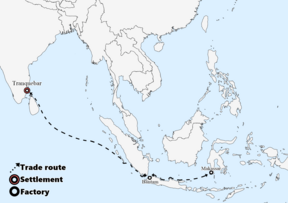This is an old revision of this page, as edited by Tinkaer1991 (talk | contribs) at 12:05, 19 April 2024 (←Created page with '{{Short description|Sieges in Tranquebar, India 1655-1669}} {{For|other sieges on Dansborg|Siege of Dansborg (disambiguation)}}{{Infobox military conflict | conflict = Sieges of Tranquebar | place = Tranquebar, (modern-day Tamil Nadu, india) | image = Map of Tranquebar.jpg | caption = Tranquebar after the improved fortifications of Eskild Andersen, 1660 | image_size = 300 | date = 16...'). The present address (URL) is a permanent link to this revision, which may differ significantly from the current revision.
Revision as of 12:05, 19 April 2024 by Tinkaer1991 (talk | contribs) (←Created page with '{{Short description|Sieges in Tranquebar, India 1655-1669}} {{For|other sieges on Dansborg|Siege of Dansborg (disambiguation)}}{{Infobox military conflict | conflict = Sieges of Tranquebar | place = Tranquebar, (modern-day Tamil Nadu, india) | image = Map of Tranquebar.jpg | caption = Tranquebar after the improved fortifications of Eskild Andersen, 1660 | image_size = 300 | date = 16...')(diff) ← Previous revision | Latest revision (diff) | Newer revision → (diff) Sieges in Tranquebar, India 1655-1669 For other sieges on Dansborg, see Siege of Dansborg (disambiguation).| Sieges of Tranquebar | |||||||||
|---|---|---|---|---|---|---|---|---|---|
 Tranquebar after the improved fortifications of Eskild Andersen, 1660 | |||||||||
| |||||||||
| Belligerents | |||||||||
|
| Thanjavur Nayak kingdom | ||||||||
| Commanders and leaders | |||||||||
|
| Vijaya Raghava | ||||||||
| Units involved | |||||||||
|
| Unknown | ||||||||
| Strength | |||||||||
|
2 Danes Few Portuguese 1 ship (1669) | Unknown; presumably large | ||||||||
| Danish colonial conflicts | |
|---|---|
| Baltic Sea
North Atlantic Africa
Asia
Caribbean |
The Sieges of Tranquebar (Danish; Belejringerne af Trankebar) refers to the warfare between the Thanjavur Nayak kingdom and Danish Tranquebar between 1655 – 1669. The Thanjavurian sieges were repelled, mainly due to the new fortifications being build around Tranquebar, and a peace agreement is issued in 1669.
Background
In 1643 the vessel Christianshavn would arrive in Tranquebar with proclaimed governor, Willem Leyel. Unbeknownst to the Danes in India would be that, this was the last ship from Denmark for 26 years: Because of the Dano-Swedish Wars Denmark did not have the means to send any new ship to India, so Tranquebar could therefore not be assited from Denmark. This led to financial difficulties and a general lack of Danish manpower.
In 1648 a mutiny broke out in Tranquebar and Leyel was subsequently arrested. He was succeded by Poul Hansen Korsør, who reigned until his death on 7 September 1655. Furthermore the first Danish East India Company was dissestablished in 1650, and the number of Danes remained only a handful.
Danish India 1643-1669 Danish settlements, factories andtrading routes in India from 1643–1669
Danish settlements, factories andtrading routes in India from 1643–1669
Arriving together with the Christianshavn in 1643, Eskild Andersen (Kongsbakke) now became the new governor of Tranquebar. Andersen would try to preserve the economy by regularly sending ships to Makassar and Bantam, and wage privateering against the Mughal Empire.
Sieges
The Nayak of the Thanjavur kingdom, Vijaya Raghava, had waged war against the Gingee and Madurai and therefore needed sufficient money. The Thanjavurians took advantage of a weakened Tranquebar and in 1655 demanded to raise the early tribute paid by Tranquebar. When Tranquebar failed to fulfill this demand Raghava sent a force to besiege Tranquebar. Though, Andersen defended the attack by the help of the local Indians: The number of Danish settlers in Tranquebar was very small, and it was therefore necessary to hire Portuguese mercenaries and Indian Sepoys to defend Fort Dansborg.
In 1660 a new siege was initiated, which would last nine months. In response Andersen started to fortify the whole town. Previously Dansborg had been the only fortified place, and the Inhabitants of Tranquebar would usually seek shelter in the fort. This was now changed, and all of Tranquebar was fortified. Andersen made the locals build a Curtain wall around the city, with four additional towers.
In May 1669 the 29-year-isolation was over with the arrival of the frigate Farø at Tranquebar. Færø arrived with soldiers and goods under the command of Henrik Eggers. As a result of Færø's arrival peace was concluded with Vijaya Raghava.
Aftermath
As a result of the peace the nayak ceded the villages of Poreiar, Tillali and Erikutanchery, which greatly enlargened Tranquebar. Meanwhile, Færø would be sent to Java to reestablish trade connections with the local sultan.
Notelist
References
- Sejerø, Olav. "Trankebarmønter med Skibsnavne". sejeroe.com. Retrieved 2024-04-18.
- ^ Bredsdorff, Asta (2009). The Trials and Travels of Willem Leyel. Copenhagen: Museum Tusculanum Press.
- ^ "Tranquebar-mønter, 1620-1670". danmarkshistorien.dk (in Danish). Retrieved 2024-04-18.
- "Danmarks koloni i Tranquebar 1616-1729 - Rigsarkivet - kilderne.dk". Kilderne (in Danish). Retrieved 2024-04-18.
- ^ Ritzau (2020-10-17). "Eskild var den eneste dansker i Trankebar". Sjællandske Nyheder (in Danish). Retrieved 2024-04-18.
- Holbek, Finn. "Skeel, Schaffalitzky og Ahlefeldt". finnholbek.dk (in Danish). Retrieved 2024-04-18.
- "P. H. Korsør - www.foreningen-trankebar.dk". 123hjemmeside.dk (in Danish). Retrieved 2024-04-18.
- ^ "Eskild alene i Tranquebar". videnskab.dk (in Danish). 2023-06-14. Retrieved 2024-04-18.
- ^ "Den danske tropekoloni i Trankebar". www.aerenlund.dk. Retrieved 2024-04-18.
- ^ "E.A.Kongsbakke - www.foreningen-trankebar.dk". 123hjemmeside.dk (in Danish). Retrieved 2024-04-18.
- ^ Gregersen, Hans (2018). Trankebar [Tranquebar] (in Danish). Forlag A/S. pp. 12–13. ISBN 9788711978337.
- ^ "Bogstaver på Frederik den Tredies blymønter". danskmoent.dk. Retrieved 2024-04-18.
- Westerbeek, Bjørn. Omkring et par tidlige kort over Tranquebar (in Danish). Københavns Rådhusbibliotek. p. 28.